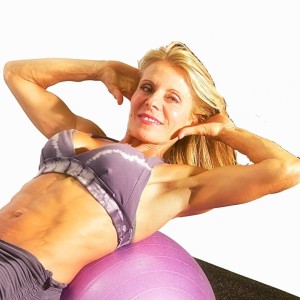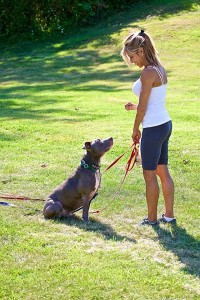Update 9/5/20. The Corrective Exercise Specialist (CES) certification offered by the National Academy of Sports Medicine (NASM) is one of the most popular personal training certifications's out there today. For those who are interested in taking this certification, I sat down with April James, a self-employed personal trainer in Titusville New Jersey about how she prepared and passed the NASM CES cert. Along the way, we also discuss many other questions that all personal trainers should know about.
Also, Read In this Series:
JC. Tell people about yourself
AJ. I have been in the fitness field most of my adult life and was even interested in fitness and health when I was a child, I was the one who always wanted to walk somewhere instead of drive. My career has evolved over time. I started off teaching fitness classes and working the desk at local gyms, and went on to get my degree in Exercise Science at TCNJ.
I was a fitness director at the YWCA in Princeton NJ for over 15 years where I developed an array of programs including personal training, group fitness, and a martial arts and spinning program.
It was at the YWCA that I began teaching certification courses for AAAI/ISMA and found that one of my greatest passions was teaching! After that, I became the fitness director at Body Tech Fitness in Lambertville, NJ in 2006 and worked there for 7 years, until they closed their doors a few years ago.
I now basically work for myself doing in-home training, teaching seminars, and a few group fitness dance classes at a premier fitness center in Ewing NJ – PEAC Health and Fitness. I often do seminars for their members on numerous topics.
I also teach certification courses for AAAI/ISMA, and conduct over 40 classes a year now. I most recently developed a new AAAI certification course called Women’s Holistic Hormonal Health Coach because I realized how influential hormone balance is for weight control and well being. Women  don't realize how much they can do to balance their hormones naturally and need to “take back the power” when it comes to their health.
don't realize how much they can do to balance their hormones naturally and need to “take back the power” when it comes to their health.
JC. Besides CES what other certs do you have?
AJ. In addition to CES, I also possess ACE personal trainer and ACE Group Fitness Instructor certs. In addition, I'm a, NSCA CSCS and ACSM Exercise Physiologist. I also am certified in Johnny G Spinning and Precision Nutrition Level 1.
JC. Why did you pick the NASM CES over other certs?
AJ. I deal with so many clients that have weaknesses and imbalances in their body and I wanted to learn how to address that and help them to overcome these issues. I always believed that “you are only as strong as your weakest link” and you can not ignore your client's weak points and imbalances. CES was just what I was looking for.
JC. Did the NASM require a CPR/AED cert before you could register for the CES?
AJ. No, they did not.
JC. Did you have to show your CPR/AED cert on the day you took the CES exam? Were any other forms of ID Needed?
AJ. No, the CES certification was an online course.
JC. Could people use their cell phones or calculators during the exam?
AJ. I would imagine they could since you are taking the course online so no one is there to monitor that.
Although the test is timed so not a lot of time to research answers. And, a lot of the test was viewing exercises and identifying which muscles are working, and which ones are misfiring.
JC. Did you have to take other NASM certs as prerequisites or could you jump right into the CES cert?
AJ. I just jumped right in, although I would not recommend that since it is quite challenging and without any basic knowledge of fitness and exercise it would probably be too challenging for most people!
JC. How much did the CES cost?
AJ. I believe the CES cost was around $895 and that was with a discount!
JC. Where did you take the cert?
AJ. Self-study at home, with a book and computer.
JC. How long did you study before you took the CES cert?
AJ. Almost a year but it could have been less if I had more time to dedicate to it.
JC. After you took the test, did you find out immediately if you passed?
AJ. Yes, I found out immediately after the exam that I passed.
JC. What books did you study to prepare for CES?
AJ. The CES book from NASM provided in the course.
JC. How many questions were on the test?
AJ. I don't remember the exact number of questions but it was over 100.
JC. What was the format of the test?
AJ. It varied. It was mostly multiple-choice, but there was a big section of matching columns; i.e. muscle to movement or overactive muscles vs. underactive muscles.
JC. Did you take it on a computer or was it a written test?
AJ. It was all taken on my computer in my home.
JC. Did the test have a practical component?
AJ. No but people were able to attend one of their all-day workshops that were included in the price of the exam.
JC. Were there any essays on the test?
AJ. No, the CES exam had no essays.
JC. Did the NASM require an internship as part of the CES program?
AJ. No, there was no internship required to pass the CES exam.
JC. What were the hardest parts of the CES test?
AJ. The hardest parts were statistics and trying to memorize percentages and numbers of things like, how many people suffer from back problems or knee problems etc. I didn't think that is a necessary component of learning this program.
JC. What did you think was the easiest part of the test?
AJ. For me, it was identifying muscles and the movements they perform and understanding those that tend to be overactive vs. those that are inhibited.
JC. If you could change anything about the CES -or NASM -what would it be?
AJ. I would provide a corresponding internship with it and have opportunities to do it with local physical therapists. I think that would make the NASM CES cert much more powerful.
JC. How do you feel obtaining the CES cert will help you as a personal trainer?
AJ. It is already helping me to address muscle imbalances in my clients and ways to correct these imbalances for better movement quality and to prevent injury in the future.
JC. What are 3 things people need to know before they become a personal trainer?
AJ. One size does not fit all! Personal Training should be just that “personal” and you must know your client (both strengths and weaknesses) before you can train them!
Always remember that the “benefit” of the exercises you chose for your clients should outweigh the “risk”……above all do no harm! Always choose exercises that are appropriate for your client's level of fitness and if there is an alternative exercise with the same benefits but less risk, that is always your best choice.
Exercise should be enjoyable and make you feel good! Too many beginners are scared away from trainers that give them too much too soon. Start slowly and micro-progress when your client is ready.
JC. What are 3 fitness myths personal trainers tend to think are true?
AJ. An exercise has to hurt to have benefits; although occasional muscle soreness is acceptable it shouldn't be constant and the pain should never be in the joints…..if it is something is not right.
1 Either improper form/technique, too much load or just too much too soon without sufficient rest in between. One must remember that we don't get stronger while we are exercising…..exercise is stress and breaks the body down. The adaptations occur when we rest and refuel properly!
2 One size fits all. Trainers have to remember that an exercise program has to fit the client and be developed and progress over time. Feedback and record-keeping are essential to know you are heading in the right direction
3 That it is easy to change someone’s habits. A healthy lifestyle is not easy to adapt if your client has been lacking in this area, as so many are. People are creatures of habit so don't get discouraged if your clients fall backward sometimes. Look for and encourage smaller changes in those that are struggling more, acknowledge and praise the good and take baby steps forward, and expect the occasional setbacks!
JC. Describe what your typical day is as a personal trainer
AJ. My schedule is not like most trainers and varies greatly from day to day. I train in people’s homes and in my home. I never train straight through all day, but rather break my day up with my volunteer dog walking at a local shelter called EASEL  or just getting out walking with my dogs.
or just getting out walking with my dogs.
This keeps me fresh and motivated for my clients and prevents major burn out. I will usually work 6-7 days a week but never a full day and always a different schedule.
JC. How can people reach out to you and learn more?
AJ. The easiest way to find me is to reach out on my Facebook page or if you in the Ewing NJ area, stop into PEAC Health and Fitness and say hi.
Leave a Reply